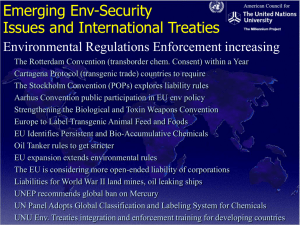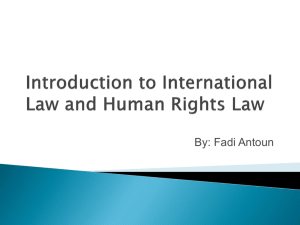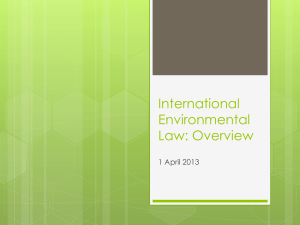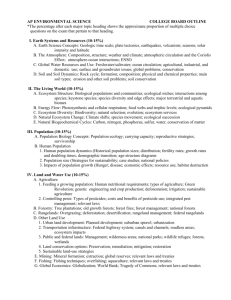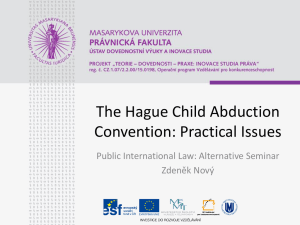Environmental Law
advertisement
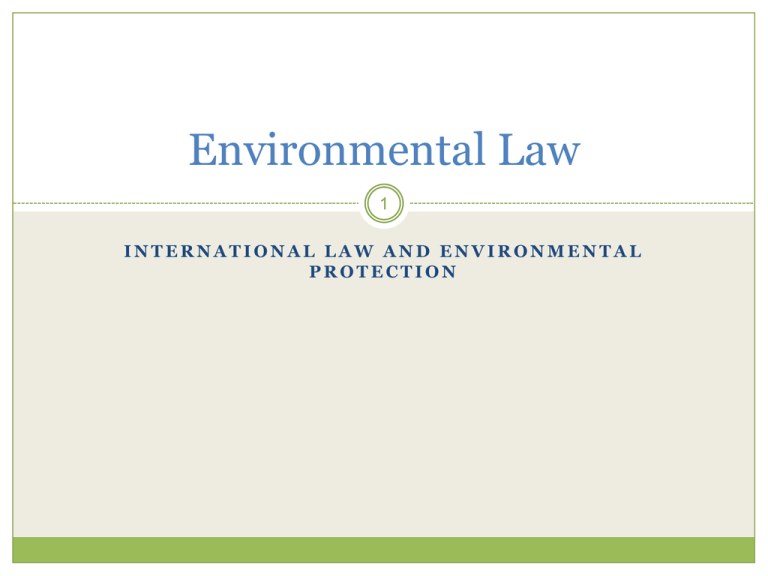
Environmental Law 1 INTERNATIONAL LAW AND ENVIRONMENTAL PROTECTION International Environmental Law 2 The Importance of International Environmental Law Regulation at international as opposed to national level Global environmental problems have global /regional /national dimensions Environmental problems not contained within national/territorial boundaries Environment is shared. Need to protect environment is paramount in relationship between States International Environmental Law 3 Transboundary and global environmental problems require international regulation and solutions International agreements /treaties /conventions establish standards International agreements have developed principles of environmental law Recent focus on procedures and incentives to secure compliance International Environmental Law 4 What is international environmental law? How is it made? What forms does it take? What is the role of international environmental law? How effective is international law in protecting the environment? How is effect given to it in the nation State? How has it developed? International Environmental Law 5 Development The Trail Smelter Case (USA v Canada) 1941 A neighbouring State has no right ‘to use or permit the use of its territory in such a manner as to cause injury by fumes in the territory of another or the properties therein.’ Serious harm and the ‘establishing of the facts through clear and convincing evidence.’ International Environmental Law 6 United Nations Conference on the Conservation and Utilisation of Resources (UNCCUR) 1949 Addressed global issues ; used economic concepts to assess minerals, fuels and energy, water, forests and land, wildlife and fish; conservation; new technologies assessed; education strategies adopted; respective economic situations of developed and developing countries determined approach; integrated development of river basins policy. International Environmental Law 7 Conservation on Law of the Sea 1954 Atmosphere 1955 – issue of nuclear testing = Test Ban Treaties 1955 International Maritime Organisation first met 1954 1971 Ramsar Convention on Wetlands 1972 Stockholm Convention on Human Environment Use and Conservation Action Plan; Declaration (26 Principles) – Principle 21 * United Nations Environment Programme (UNEP) International Environmental Law 8 1987 World Commission on Environment and Development Our Common Future Brundtland Report Sustainable Development. 1992 UN Conference on Environment and Development - Rio – 176 States attended. Rio Declaration Convention on Biological Diversity Framework Convention on Climate Change Agenda 21 International Environmental Law 9 Relationship with national law International law = relationship between States International law is not directly enforceable in the national legal system in the United Kingdom Treaties need to be ratified by government Need to be given effect by Parliament Treaties are required to be given effect by implementation of national legislation Only then has international law direct application International Environmental Law 10 The Sources of International Law Hard and Soft Law 1. Treaties –bind State in relations with other States 2. 2. Customary International Law Implicit; Influence; Flexible Facilitative of development of principles of International environmental law Requires State practice + conviction that legally bound International Environmental Law 11 3. Judicial Decisions – International Court of Justice Three cases heard per year Absence of binding precedent – binding inter partes Authority accepted by less than 1/3 of UN; Delay International Lawyers opinions have considerable influence on development of international law Nuclear II case New Zealand v France [1995] ICJ Rep 288 States have responsibilities not to cause environmental damage beyond national or jurisdictional boundaries International Environmental Law 12 4.Soft Law (Advantages over binding law) Declarations Consolidate Move principles towards customary status Reflect agreed international political aspirations Principles Sustainable Development-duties to future generations Common but differentiated responsibilities (climate) Recommendations . Standards. International Environmental Law 13 Effectiveness? No Enforcement Body Limited role of Court Depends on implementation and monitoring provisions in each Treaty Institutions Procedures NGO’s Collating information Liability compensatory regimes / hazardous activities Public participation new direction?
